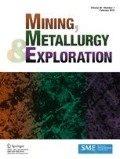Abstract
In the present study, the use of horse residue as an alternative reducing agent in the roasting of a low-grade goethite ore containing 17.60% Fe was investigated. Additional roasting experiments were carried out with corn starch and without reducing agent for comparison. Each roasted product was characterized using X-ray diffraction (XRD) and magnetic hysteresis (MH) loops analyses. The optimum roasting conditions (roasting temperature [400, 500, and 600 °C], reducing agent/ore ratio [0.04, 0.08, and 0.12], and roasting time [10, 20, and 30 min]) were investigated based on the Taguchi approach. The magnetic susceptibilities of the roasted sample with the addition of reducing agents were higher compared to that of the roasted sample in the absence of reducing agent. Experimental findings indicate that the horse residue can be used as the reducing agent. Finally, an iron ore concentrate assaying a Fe grade of 62.12% with a recovery of 56.93% was prepared using wet magnetic separation at a magnetic intensity of 0.5 T from the ore roasted under the following roasting conditions: roasting temperature of 500 °C, reducing agent/sample ratio of 0.08, and roasting time of 30 min.







Similar content being viewed by others
References
Ponomar VP (2018) Thermomagnetic properties of the goethite transformation during high-temperature treatment. Miner Eng 127:143–152
Jang K-o, Nunna VRM, Hapugoda S, Nguyen AV, Bruckard WJ (2014) Chemical and mineral transformation of a low grade goethite ore by dehydroxylation, reduction roasting and magnetic separation. Miner Eng 60:14–22
Ravisankar V, Venugopal R, Bhat H (2017) Investigation on beneficiation of goethite-rich iron ores using reduction roasting followed by magnetic separation. Miner Process Ext Metall 128:175–182
Li C, Sun H, Bai J, Li L (2010) Innovative methodology for comprehensive utilization of iron ore tailings: part 1. The recovery of iron from iron ore tailings using magnetic separation after magnetizing roasting. J Hazard Mater 174:71–77
Ponomar VP (2018) Synthesis and magnetic properties of magnetite prepared by chemical reduction from hematite of various particle sizes. J Alloys Compd 741:28–34
Ponomar VP, Dudchenko NO, Brik AB (2017) Reduction roasting of hematite to magnetite using carbohydrates. Int J Miner Process 164:21–25
Wu Y, Fang M, Lan L, Zhang P, Rao KV, Bao Z (2012) Rapid and direct magnetization of goethite ore roasted by biomass fuel. Sep Purif Technol 94:34–38
Vapur H, Top S, Altiner M, Uçkun Ş, Sarikaya M (2020) Comparison of iron ores upgraded with Falcon concentrator and magnetic separators assisted by coal reduction-conversion process. Part Sci Technol 38:409–418
Zhang X, Han Y, Sun Y, Li Y (2019) Innovative utilization of refractory iron ore via suspension magnetization roasting: a pilot-scale study. Powder Technol 352:16–24
Peng T, Gao X, Li Q, Xu L, Luo L, Xu L (2017) Phase transformation during roasting process and magnetic beneficiation of oolitic-iron ores. Vacuum 146:63–73
Yu J, Han Y, Li Y, Gao P (2017) Beneficiation of an iron ore fines by magnetization roasting and magnetic separation. Int J Miner Process 168:102–108
Rath SS, Rao DS, Mishra BK (2016) A novel approach for reduction roasting of iron ore slime using cow dung. Int J Miner Process 157:216–226
Wu F, Cao Z, Wang S, Zhong H (2017) Phase transformation of iron in limonite ore by microwave roasting with addition of alkali lignin and its effects on magnetic separation. J Alloys Compd 722:651–661
Sun Y, Zhu X, Han Y, Li Y (2019) Green magnetization roasting technology for refractory iron ore using siderite as a reductant. J Clean Prod 206:40–50
Rath SS, Rao DS (2017) Dolochar as a reductant in the reduction roasting of iron ore slimes. Int J Miner Metall Mater 24:1341–1351
Nayak D, Dash N, Ray N, Rath SS (2019) Utilization of waste coconut shells in the reduction roasting of overburden from iron ore mines. Powder Technol 353:450–458
Rashid RZA, Yunus NA, Salleh HM, Ani MH, Akiyama T, Purwanto H (2014) Enhancement of magnetic properties of Malaysian iron ore by reduction roasting using oil palm empty fruit bunch. ISIJ Int 54:994–996
Rath SS, Rao DS, Tripathy A, Biswal SK (2018) Biomass briquette as an alternative reductant for low grade iron ore resources. Biomass Bioenergy 108:447–454
Hunt CP, Moskowitz BM, Banerjee SK (1995) Magnetic properties of rocks and minerals. In: Ahrens TJ (ed) Rock Physics and Phase Relations: a handbook of physical constants, AGU Ref. Shelf, vol 3. AGU, Washington, D.C, pp 189–204
Tadic M, Panjan M, Damnjanovic V, Milosevic I (2014) Magnetic properties of hematite ( α-Fe2O3) nanoparticles prepared byhydrothermal synthesis method. Appl Surf Sci 320:183–187
Higuchi K, Heerema RH (2003) Influence of sintering conditions on the reduction behaviour of pure hematite compacts. Miner Eng 16:463–477
Funding
This study was supported by Cukurova University (Project No. FBA-2019-10123).
Author information
Authors and Affiliations
Corresponding author
Ethics declarations
Conflict of Interest
The author declares that there is no conflict of interest.
Additional information
Publisher’s Note
Springer Nature remains neutral with regard to jurisdictional claims in published maps and institutional affiliations.
Rights and permissions
About this article
Cite this article
Altiner, M. Roasting of a Low-Grade Goethite Ore Using Horse Residue and Its Beneficiation by Magnetic Separation. Mining, Metallurgy & Exploration 37, 1357–1365 (2020). https://doi.org/10.1007/s42461-020-00242-5
Received:
Accepted:
Published:
Issue Date:
DOI: https://doi.org/10.1007/s42461-020-00242-5


